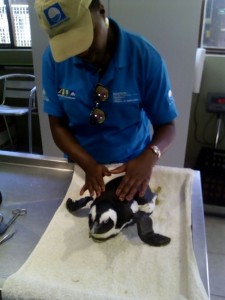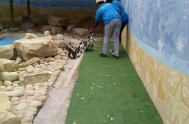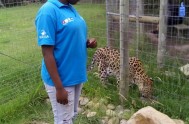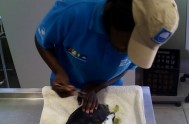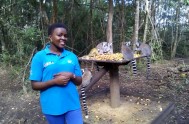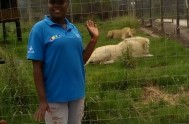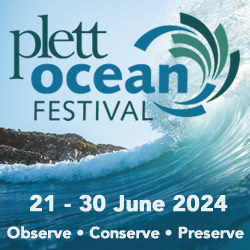
Aphindiwe Dwashu and Tshidi Luzipho recently spent 3 days experiencing a few of Plett’s activities. Their report follows:
Day 1: Tourism Office
We arrived at the tourism office for confirmation of the organisations we would be visiting.
Day 2: Tourism Office
We met with Patty from Plett Tourism Media. She explained to us what she does and what’s happening in the Plett Media Industry. She told us about the Wine Tours and mentioned she could take us to wine tasting farms to familiarize us with the Plett wine farms. She advised us that if ever we take part in activities or events we should feel free to post them on Social Media and hastag them #plettitsafeeling.
Day 3: Knysna Elephant Park
 Visiting Knysna Elephant Park was an awesome experience. The first person to welcome us was Dave. He was friendly and he introduced us to the staff. One of them was Georgia who is an Elephant researcher. She showed us around the park, explaining to us how elephants live. She took us to the paper recycling room where we learnt how the paper dung is made. They mix white or brown paper with elephant dung to get a paper dung. It depends which paper you mix with the dung. You can even make envelopes, wrapping paper and kids colouring paper.
Visiting Knysna Elephant Park was an awesome experience. The first person to welcome us was Dave. He was friendly and he introduced us to the staff. One of them was Georgia who is an Elephant researcher. She showed us around the park, explaining to us how elephants live. She took us to the paper recycling room where we learnt how the paper dung is made. They mix white or brown paper with elephant dung to get a paper dung. It depends which paper you mix with the dung. You can even make envelopes, wrapping paper and kids colouring paper.
Then we went to the Boma. That’s where the Elephants sleep at night, in separated quarters, males apart from females. The Boma is also used to monitor and observe the elephant behaviour at night using instantaneous sampling. We went to the field where we had the opportunity to interact, feed and walk amongst the herd of African elephants. We also did the elephant observation and monitoring survey, gaining insight into all aspects of elephant life at the field.
We visited their lab and we met Christina who is doing biological material. Her duty is to prepare elephant hormones by dry freezing the elephant dung, which takes 24 hours. The dung is collected twice a week and they keep the dung for samples. Those samples can be kept for a period of 10 years and helps them to identify the changes in elephant behaviour.
We learnt many interesting things regarding elephants e.g. that they are more likely to be like human beings because they have feelings, they can grieve and console each other when something bad happens to one another etc. One of the interesting things we learnt is that big elephants stand on their feet when they sleep because they are heavy, so this avoids putting pressure on their heart. They are very intelligent and they know exactly how to behave in the presence of visitors.
Day 4: Tenikwa Wildlife Rehabilitation and awareness Centre
Tenikwa accepts injured, abandoned or displaced wild animals from the Garden Route. They are treated, cared for and when ready, returned to the wild where they belong. We were introduced to a lady called Boniwe who was working at the Lab, and she explained to us what she does every day. She also showed us how to feed and give medication to the animals and she let us do this by ourselves during the morning and afternoon routine. That was a great experience because we have never before had an opportunity to take care of wild animals.
We learnt that you can’t be under stress when taking take of animals, as they will feel that you are not giving them enough love and care so they become aggressive, and they won’t even eat. As human beings it is our duty to make sure the animals are well taken care of by ensuring the environment is friendly, clean and safe at all times. Doing this helps to reduce the number of animals who may get sick or injured.
Visiting Tenikwa taught us to take care of animals as much as we take care of ourselves. Another thing it highlighted is that you need to be brave because you will dealing with wild animals such as lion, cheetah and leopard. All in all it was a fantastic, fun learning experience, but scary at the same time.
Day 5: Monkey Land and Birds of Eden
 The last day of our itinerary was at Monkeyland and Birds of Eden, were we met 550 monkeys at the forest which contains 11 different species. They took us on a tour and explained the ways in which monkeys live and how they interact with one another.
The last day of our itinerary was at Monkeyland and Birds of Eden, were we met 550 monkeys at the forest which contains 11 different species. They took us on a tour and explained the ways in which monkeys live and how they interact with one another.
Most of these monkeys were brought in by people who were keeping them as pets, not realising that they were taking away their freedom of living in the wild.
Monkeyland gives the monkeys another chance to live in the wild. They feed the monkeys three times a day with eggs, corn, fruit, vegetables and chicken meat. We also helped the staff to prepare the food for the animals.
BIRDS OF EDEN
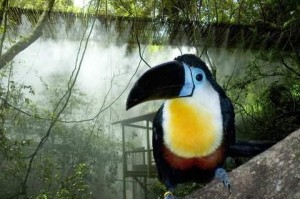 Later that day we visited Birds of Eden which is the largest single dome free aviary in the world, with almost 3 500 birds and over 200 different species. We walked along the boardwalk that is about 2.3 hectares of natural forest, streams and dams.
Later that day we visited Birds of Eden which is the largest single dome free aviary in the world, with almost 3 500 birds and over 200 different species. We walked along the boardwalk that is about 2.3 hectares of natural forest, streams and dams.
Birds of Eden also collect birds that have been kept as pets because of their beautiful colours. The main thing they do is to keep the birds inside their covered forest which teaches the birds how to look after themselves again in the wild.
It was a great learning opportunity for us visiting all these organisations. We learnt a lot and it gave us more interest in the tourism sector and understanding of wildlife. Environmental conservation is the way to go!!!
- Tenikwa Wildlife Rehabilitation Centre
- Assisting with the rehabilitation of a P...



